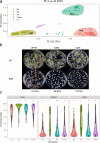Genome-wide association study revealed genetic variations of ABA sensitivity controlled by multiple stress-related genes in rice
- PMID: 37676585
- PMCID: PMC10441979
- DOI: 10.1007/s44154-021-00011-4
Genome-wide association study revealed genetic variations of ABA sensitivity controlled by multiple stress-related genes in rice
Abstract
Abscisic acid (ABA) is a critical phytohormone that regulates multiple physiological processes including plant growth and stress tolerance. The core ABA signaling pathway has been well established, but genetic variations mediating ABA responses remain largely unknown. In this study, we performed genome-wide association study (GWAS) to identify loci and genes associated with ABA sensitivity (reflected by seed germination inhibition by ABA) in a panel of 425 rice accessions. The seed germination assay revealed that Aus and indica rice had stronger ABA sensitivity than japonica rice. A total of 48 non-redundant association loci were detected in the indica subpopulation and whole population, and 386 genes in these loci were responsive to ABA or abiotic stresses. Eight association loci were overlapped with previously reported loci for yield under drought stress or for drought-indicative image traits. Haplotype analyses of important candidate genes such as OsSAPK6, a key component in the ABA signaling core, were performed to identify key SNPs/InDels that may affect gene functions through promoter activity regulation, amino acid variation, or gene splicing. These results provide insights into the genetic basis of ABA sensitivity related to stress responses.
Keywords: ABA sensitivity; Rice; Seed germination; Stress response.
© 2021. The Author(s).
Conflict of interest statement
Author LX is a member of the Editorial Board, but was not involved in the journal's review of, or decisions related to, this manuscript.
Figures




Similar articles
-
The basic helix-loop-helix transcription factor gene, OsbHLH38, plays a key role in controlling rice salt tolerance.J Integr Plant Biol. 2023 Aug;65(8):1859-1873. doi: 10.1111/jipb.13489. Epub 2023 May 10. J Integr Plant Biol. 2023. PMID: 36988217
-
Genome-wide association mapping revealed a diverse genetic basis of seed dormancy across subpopulations in rice (Oryza sativa L.).BMC Genet. 2016 Jan 25;17:28. doi: 10.1186/s12863-016-0340-2. BMC Genet. 2016. PMID: 26810156 Free PMC article.
-
Genome-wide association study of salt tolerance at the seed germination stage in rice.BMC Plant Biol. 2017 May 30;17(1):92. doi: 10.1186/s12870-017-1044-0. BMC Plant Biol. 2017. PMID: 28558653 Free PMC article.
-
Genetic architecture of cold tolerance in rice (Oryza sativa) determined through high resolution genome-wide analysis.PLoS One. 2017 Mar 10;12(3):e0172133. doi: 10.1371/journal.pone.0172133. eCollection 2017. PLoS One. 2017. PMID: 28282385 Free PMC article.
-
The abscisic acid receptor OsPYL6 confers drought tolerance to indica rice through dehydration avoidance and tolerance mechanisms.J Exp Bot. 2021 Feb 24;72(4):1411-1431. doi: 10.1093/jxb/eraa509. J Exp Bot. 2021. PMID: 33130892
Cited by
-
Genome-wide identification and expression analysis of soybean bHLH transcription factor and its molecular mechanism on grain protein synthesis.Front Plant Sci. 2025 Feb 19;16:1481565. doi: 10.3389/fpls.2025.1481565. eCollection 2025. Front Plant Sci. 2025. PMID: 40046949 Free PMC article.
References
-
- Chae MJ, Lee JS, Nam MH, Cho K, Hong JY, Yi SA, Suh SC, Yoon IS. A rice dehydration-inducible SNF1-related protein kinase 2 phosphorylates an abscisic acid responsive element-binding factor and associates with ABA signaling. Plant Mol Biol. 2007;63(2):151–169. doi: 10.1007/s11103-006-9079-x. - DOI - PubMed
Grants and funding
LinkOut - more resources
Full Text Sources

